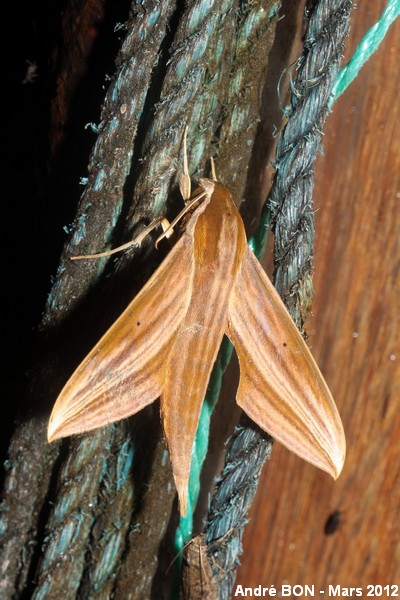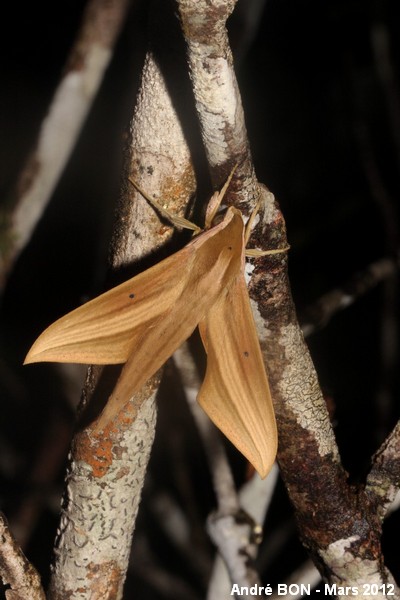

| Xylophanes neoptolemus (Cramer, 1780) |


|
|
Scientific name: Xylophanes neoptolemus (Cramer, 1780) Common name: French name: Order: Lepidoptera Suborder: Heterocera Family: Sphingidae Subfamily: Macroglossinae Wingspan: Males: 65-72mm; Females: 73-82mm. Biotope: Tropical rain forests. Geographic area: Venezuela, Trinidad, Guyana, Suriname, French Guiana, north-western Brazil (and maybe more widespread throughout South America). Flight time: All year round. Number of generations : Caterpillar: Dark brown with the small typical tail of the Sphingidae family. The flanks show white diagonal lines. The head and the first segments of the thorax can retract under the abdomen which shows two large lateral ocelli. The front part of the caterpillar then resembles the head of a snake. Host plant: Psychotria horizontalis, Psychotria nervosa and Psychotria microdon. |
Xylophanes neoptolemus is a sphinx moth which is very similar to several species of the same genus. The fore wings show a series of pale brown, yellow or darker pinkish brown lines radiating from the apex to the base of the wings. The median area is paler and it bears two thin solid and dark lines running from the apex to the base of the wing. There is a small black dot on the upper side of the head and one on each fore wing. The tegulae are clearly orange. The upper side of the thorax shows a pale grey patch extending over the abdomen as two lines outlining one brown or dark olive grey median line. The hind wings bear a bright red median band. The red colour of the upper side of the hind wings is duller on Xylophanes loelia and Xylophanes libya (but you need a view of the upper side of the hind wings, this is not easy without capture). Those both species do not have so well marked dorsal lines on the upper side of the abdomen. The upper side of the fore wings appears less contrasted and without any pinkish colour. There are other similar species in Central America. |
| [To know more about the Xylophanes neoptolemus] [Next picture] [Top] |

|
I have shot this picture at Roura, at Camps Patawa, during a light trap night session. Though I do not have any view of the hind wings, the slightly pinkish colour, the orange tegulae and the well marked dorsal lines match quite well the Xylophanes neoptolemus species. |
| [To know more about the Xylophanes neoptolemus] [Previous picture] [Top] |

|
This specimen does not show any pinkish colour. The tegulae are not much in contrast with the body's colour. The dorsal line on the abdomen are not very well marked. So I think that this one is Xylophanes loelia or Xylophanes libya but I cannot tell them apart without a view of the upper side of the hind wings. |